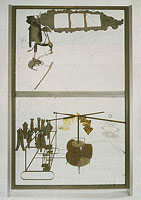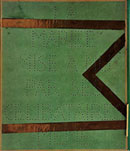Complexity Art by Roberto Giunti |
|||||||||
|
In the conclusion of my article for the fourth issue of Tout-Fait Journal (1), I identified a possible theme in the artistic events of the 1900’s. I'm referring to the gradual emergence, in art, of important ideas and conceptual themes which also belong to the grounding kernel of the complexity sciences. As a first step, my concern was (and still is) to illuminate some unexpected links, all of them directly related to some fundamental ideas of complexity, between some leading figures in twentieth century art, namely Klee, Duchamp and Escher. This unexpected relationship is even more surprising considering the radical differences between their personalities and their artistic results, or at least the retinal (to use a duchampian term) ones. Furthermore, as far as I know, there is nothing in their writings that links these artists. Relations between Duchamp, Klee and Escher cover a huge range of ideas, and the complexity sciences provides us with a realm in which we can unify them. At the yearly conference “Matematica e Cultura” in Venice (2), organized by Prof. Michele Emmer, I gave a talk titled “Strands of complexity in art: Klee, Duchamp and Escher”, (3) where I presented some preliminary findings of my research. This article supplements those preliminary findings with new analogies. I'll start by summarizing those first ideas; and then I'll introduce other subjects, such as evolution, topology, impossible 3D objects and enlarged conceptions of perspective. Finally I'll try to relate these themes with those of complexity. 1. A summary of preliminary findings I divided the common traits between Klee, Duchamp and Escher into three groups, all of them mathematically relevant and strictly related to each other and to corresponding complexity themes. They are: a. Recursion and fractals b. Feedback loops and self organization c. Instability and chaos (Particularly for the a. and b. points, I took the most part of my argument about Duchamp from my article on Tout-Fait Journal cited above, where the reader can find some detailed explanations about the subjects summarized below). a. In Escher's work the role of recursion, and the presence of fractal structures have been well known and accepted since the appearance of Hofstadter’s classic book (4). As far as Duchamp is concerned, recursive structures underlie not only several individual works, but also creative processes on a larger scale, involving several works at once. I also suggested the presence (at least in embryonic form) of the idea of fractal structures, mainly linked to the typical duchampian procedure of repetition on a lower (reduced) scale. Much of Klees work is based on recursive (iterative) procedures. Klee called them progressions. They are mainly related to natural processes. In relation to natural processes Klee’s intuition of abstract mathematical concepts, like fractal dimensions (ie non-integer dimension), is notable, especially in relation to the botanical world. b.
Here Escher’s use of tessellation comes to mind. A game of symmetries could be seen as a complex system, where very simple rules (namely the given symmetries) exert their reciprocal feedback locally; as well as interacting to have dramatic, global and complex consequences on the whole tiling system. This can be (meaningfully) related to concepts regarding morphogenesis: simple rules can create global complexity, provided that the components of the system are sufficiently connected to each other. In most of Klee’s works we can see feedback loops in action, both negative and positive. True dynamic systems are the results of these loops. Klee relates them to morphogenetic processes. Once again, the key point is: local simplicity coupled with a huge network of connections) can determine the emergence of global organizational patterns. Several of Duchamp’s wordplays show self-organizing properties. In a broader sense there are similar random self-organizing processes acting in the Glass. (Fig. 1) c. Looking at Escher’s prints, exposure to conflicting stimuli (such as black-white, concave-convex, figure-background) destabilizes the observer. This theme has been already widely discussed by scholars (5). Also, Escher is particularly interested in whirling structures that draw together self-reference, fractal structures and whirling, chaotic motions.
It is well known that instability plays a key role in Klee’s compositions. Moreover Klee was attracted by what nowadays is called deterministic chaos, ie. unpredictable, irregular behavior, rising from the iterations of simple deterministic procedures. A number of different figurative frameworks are borne out of iterative procedures that have been triggered to behave irregularly. The most interesting thing, however, is that from such quite chaotic tangles of lines, often perfect vital and shiny forms emerge. An interesting analogy can be drawn here with the edge-of-chaos idea of complexity. Instability and chaos are quite typical duchampian themes. His wordplays depend on predetermined lexical conditions; the slightest differences in either a single syllable or letter or even simply intonation could cause radical shifting in the meaning of a sentence (here we have a true sensitive dependence on initial conditions). Furthermore, Duchamp saw the creative power of instability. In the loosest sense it could be seen everywhere in the Glass and in the Notes of the Green Box, (Fig. 2) but more specifically we see that in the works based on rotatory motion, where highly unstable planar sets of rotating circles can create the illusion of the stable third dimension. Here again the creative power of instability has been exploited which is also powerful edge-of-chaos idea. >>Next
Notes
Figs.
1-2
|














